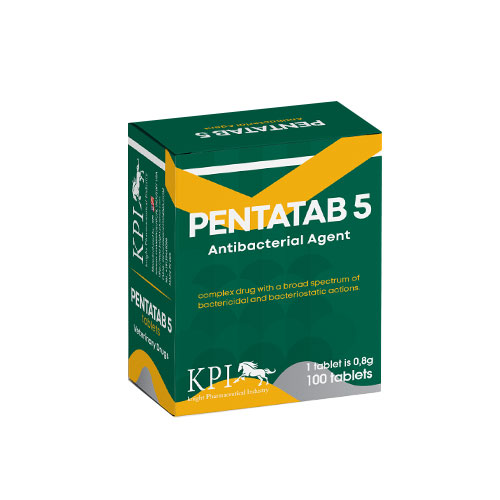Antibacterial Agent

COMPOSITION:
1 tablet (0.8 g product) contains active substances:
Sulfadimine – 70 mg;
Oxytetracycline hydrochloride – 45 mg;
Trimethoprim – 30 mg;
Tylosin tartrate – 25 mg;
Norsulfazole – 80 mg.
DESCRIPTION:
Cylindrical tablets with a flat surface, scored and beveled, from light yellow to yellow. Marbling inclusions on the surface are allowed.
PHARMACOLOGICAL CHARACTERISTICS:
Pentatab 5 is a complex drug with broad-spectrum bactericidal and bacteriostatic actions.
- Sulfadimine: Active against gram-positive and gram-negative bacteria such as E. coli, Shigella spp., Klebsiella spp., and others. It works by inhibiting dihydropteroate synthetase, disrupting tetrahydrofolic acid synthesis.
- Oxytetracycline: A bacteriostatic antibiotic effective against a wide range of gram-positive and gram-negative microorganisms by disrupting protein synthesis in bacteria.
- Trimethoprim: A chemotherapeutic agent with bactericidal action, inhibiting bacterial reductase necessary for purine and nucleic acid synthesis.
- Tylosin: A macrolide antibiotic effective against gram-positive and some gram-negative microorganisms, rickettsia, spirochetes, and mycoplasma by inhibiting protein synthesis.
APPLICATION:
- Calves: Treatment of gastroenteritis, salmonellosis, pasteurellosis, campylobacteriosis.
- Pigs: Treatment of enzootic pneumonia, arthritis, dysentery, edema disease, erysipelas, salmonellosis, pasteurellosis.
- Sheep: Treatment of septicemia, contagious agalactia.
- Rabbits: Treatment of pasteurellosis, salmonellosis, septicemia.
- Poultry (Broilers, Turkeys, Geese, Ducks): Treatment of typhus, cholera, salmonellosis, mycoplasmosis, rhinitis.
DOSAGE:
- Administer orally with dry or wet feed, either individually or by group method, after crushing the tablets.
- Daily dose for all types of animals: 0.8-1.2 g (1-1.5 tablets) per 10 kg of body weight, divided into two doses.
- The first application dose may be doubled depending on severity.
- Treatment duration: 3-5 days until symptoms disappear. For relapses, continue treatment for at least three days after full recovery.
- For coccidiosis: 2-3 courses of treatment with 5-7 days intervals.
CONTRAINDICATIONS:
- Hypersensitivity to any components.
- Animals with liver or kidney diseases.
- Functionally developed ruminants and laying hens producing eggs for human consumption.
PRECAUTIONS:
- Meat consumption is allowed after 8 days from the last application. If consumed earlier, it should be fed to unproductive animals or disposed of according to veterinary guidance.
PACKAGING :
Blister of 100 tablets per carton.
STORAGE:
- Store in a dry, dark place out of children’s reach at a temperature between 4°C and 25°C.
- Do not store with food, drinks, or animal feeds.
FOR VETERINARY USE ONLY!
